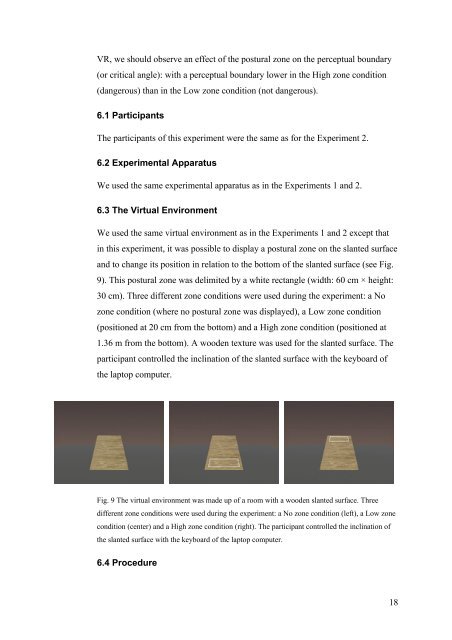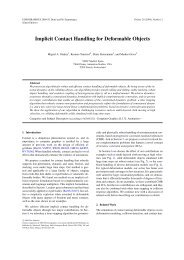Perceiving affordances in virtual reality: Influence of person ... - GMRV
Perceiving affordances in virtual reality: Influence of person ... - GMRV
Perceiving affordances in virtual reality: Influence of person ... - GMRV
You also want an ePaper? Increase the reach of your titles
YUMPU automatically turns print PDFs into web optimized ePapers that Google loves.
VR, we should observe an effect <strong>of</strong> the postural zone on the perceptual boundary<br />
(or critical angle): with a perceptual boundary lower <strong>in</strong> the High zone condition<br />
(dangerous) than <strong>in</strong> the Low zone condition (not dangerous).<br />
6.1 Participants<br />
The participants <strong>of</strong> this experiment were the same as for the Experiment 2.<br />
6.2 Experimental Apparatus<br />
We used the same experimental apparatus as <strong>in</strong> the Experiments 1 and 2.<br />
6.3 The Virtual Environment<br />
We used the same <strong>virtual</strong> environment as <strong>in</strong> the Experiments 1 and 2 except that<br />
<strong>in</strong> this experiment, it was possible to display a postural zone on the slanted surface<br />
and to change its position <strong>in</strong> relation to the bottom <strong>of</strong> the slanted surface (see Fig.<br />
9). This postural zone was delimited by a white rectangle (width: 60 cm × height:<br />
30 cm). Three different zone conditions were used dur<strong>in</strong>g the experiment: a No<br />
zone condition (where no postural zone was displayed), a Low zone condition<br />
(positioned at 20 cm from the bottom) and a High zone condition (positioned at<br />
1.36 m from the bottom). A wooden texture was used for the slanted surface. The<br />
participant controlled the <strong>in</strong>cl<strong>in</strong>ation <strong>of</strong> the slanted surface with the keyboard <strong>of</strong><br />
the laptop computer.<br />
Fig. 9 The <strong>virtual</strong> environment was made up <strong>of</strong> a room with a wooden slanted surface. Three<br />
different zone conditions were used dur<strong>in</strong>g the experiment: a No zone condition (left), a Low zone<br />
condition (center) and a High zone condition (right). The participant controlled the <strong>in</strong>cl<strong>in</strong>ation <strong>of</strong><br />
the slanted surface with the keyboard <strong>of</strong> the laptop computer.<br />
6.4 Procedure<br />
18





